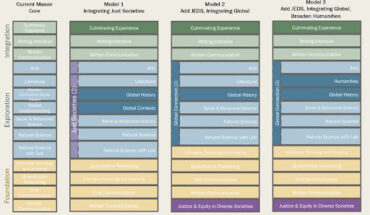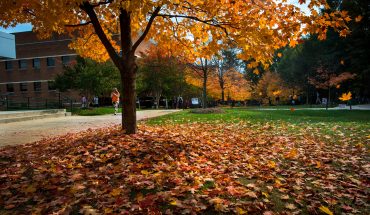Provost and faculty help in the creation of the Master Plan, a framework intended to shape the development of the university
BY SUDIKSHA KOCHI, STAFF WRITER
Senior Vice President of Administration and Finance Carol Kissal announced Mason’s new Master Plan on April 1.
A survey was sent out to students asking them to identify their favorite campus spots, draw out typical routes and leave feedback regarding Mason’s campuses.
“Overall, I’m most excited for the completion of the Core Campus Project … as I greatly miss the old features of campus [present] when I first toured in 2017,” sophomore biology major Sean Diment said in a message to Fourth Estate.
He continued, “I am hoping Mason will be more proactive with future construction developments, especially with the consideration of how it will affect the current, and not just the future students.”
According to Kissal, the goals of the Master Plan include identifying campus visions for the upcoming years that will provide a high-quality environment for learning, establishing better connections between the buildings on campus for students, maximizing the use of resources while improving space utilization and increasing student research programs.
“This Master Plan will be something that is not just implemented on the Fairfax Campus, but the Arlington and Sci-Tech campuses as well,” Kissal said.
Kissal championed a document that would capture what kept the university connected, the assessment of the buildings, how well they operate for students and what can be further improved at Mason to help students adapt to future growth.
“When I first came to Mason a year ago, one of the first things I asked the administration for was the Master Plan,” Kissal said. “I was surprised when I learned that Mason’s Master Plan was from 2002. Any large institution like Mason should have a conceivable plan that serves as a framework for decision making.”
Kissal believes that the primary motive of the plan is to aid the university in making well-informed decisions for campus surroundings for the upcoming semesters and to create a long-term vision that will push the university to grow.
“It is a plan for the future,” Kissal said. “It is a framework that will help shape and benefit Mason in the long-run.”
Along with Kissal, a large committee composed of provost members and other faculty helped with the creation of the Master Plan. Interim Provost and Executive Vice President Mark Ginsberg was also involved in these efforts.
“The plan is strategic with respect to how we plan our campus and how we plan both facilities as well as to the entire university community a resolution for a successful future,” Ginsberg said. “I think the gist of it is to evolve a community.”
According to Ginsberg, some of the construction projects — such as the new academic building and the memorial to the enslaved people of George Mason — taking place on the Fairfax campus are in accordance with the Master Plan.
“The Memorial to the Enslaved People project will definitely be one of the highlights of our Master Plan,” Ginsberg said.


